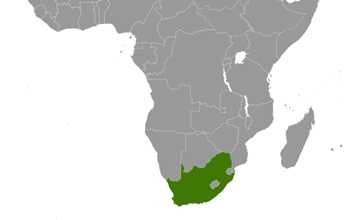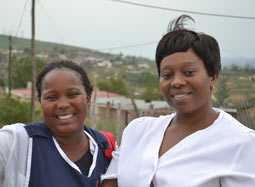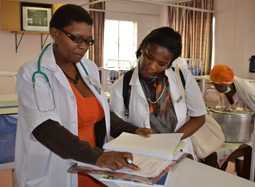
The Centers for Disease Control and Prevention (CDC) began working in South Africa in 1989, assisting nongovernmental and community-based organizations working to combat HIV. In 1994, at the onset of democracy in South Africa, CDC began to collaborate with the South African National Department of Health (NDOH) to conduct public health epidemiology training; develop national health goals and objectives; develop national HIV clinical, ethical, and research guidelines; and support HIV and tuberculosis (TB) programs. CDC plays an essential role in implementing the U.S. President’s Emergency Plan for AIDS Relief (PEPFAR).

At A Glance
Population: 55,700,000
Per capita income: $12,830
Life expectancy at birth: W 64/M 60 yrs
Infant mortality rate: 34/1000 live births

Top 10 Causes of Death
1. TB
2. Diabetes
3. Cerebrovascular Diseases
4. Other forms of Heart Disease
5. HIV
6. Influenza & Pneumonia
7. Hypertensive Diseases
8. Other viral diseases
9. Chronic Lower Respiratory Diseases
10. Ischaemic Health Disease
Source: Population Reference Bureau 2015:
Source: http://www.statssa.gov.za/
Why We’re Here
Where We Work

CDC works with approximately 55 prime partners and 200 sub-partners in all nine of South Africa’s provinces and with the national, provincial, and district health departments.
What CDC Is Doing

CDC works with partners to improve the country’s public health foundation, prevent HIV, provide HIV care, and strengthen lab capacity.
Who We Are
Our Stories
-
Peer educators stepping up HIV prevention and treatment adherence in prisons
“We have seen a shift in how inmates and officials now openly talk about sex, sexual violence and HIV at Zonderwater. HCT uptake is also on the rise as inmates understand that HIV is not a death sentence, and there are peer educators who are there to support them. Condoms are also now widely accessible, something that never happened in the past.” Mr. Masizole Gonyela, Prevention Program Manager at SA Partners
Posted October 13, 2017
-
StepUP goes where others fear to tread to stop the spread of HIV
“To have over 20 homeless PWID on ART and to achieve viral suppression with more than half of them is a success because these are people whom one would expect to struggle with adhering to treatment due to the conditions in which they live,” said Angela McBride, PWID Project Coordinator.
October 13, 2017
-
Driving data innovations: Real-time quality data critical
“Looking at data four or five months in arrears is insufficient. The idea is to put yourself closer to the data for immediate identification of progress and required corrective action.” Patrick Nadol, Branch Chief, Epidemiology and Strategic Information, CDC South Africa.
Posted October 13, 2017
In the News
Impact on South Africa
South Africa was one of the first countries in Africa to adopt the Test and Treat policy in September 2017 making treatment available to all people living with HIV regardless of CD4 count, .
CDC South Africa’s laboratory program has implemented a quality improvement system within 1,159 facilities providing HIV-rapid testing within the 27 focus districts in the country. The first cycle of proficiency testing has seen a passing rate of 97% for all facilities enrolled.
More than 95% of TB patients at CDC- supported facilities were tested for HIV, and of those co-infected with HIV, 85% were initiated on ART.
HIV/AIDS
Through PEPFAR, the CDC South Africa office supports the NDOH through HIV treatment services and a comprehensive combination prevention strategy. Using a data-driven approach, this strategy is tailored to the unique characteristics of the local epidemic to boost health impact. Activities include the expansion of prevention services, including the prevention of mother-to-child transmission (PMTCT) of HIV, antiretroviral therapy (ART), and voluntary medical male circumcision (VMMC).
The South Africa ART program surpassed their goal of 3.5 million persons currently on ART, with a total of 3.614 million people living with HIV (PLHIV) on treatment as of September 2016. CDC-supported healthcare facilities provide treatment for more than 1.3 million of these PLHIV.
Adolescent girls (15-19 years) are up to eight times more likely to be HIV- infected, while young women (20-24 years) are more than three times more likely to be infected than their male peers; as a result, adolescent girls and young women (AGYW) are a key focus area for CDC South Africa. Determined, Resilient, Empowered, AIDS-free, Mentored, and Safe (DREAMS) is a partnership to reduce HIV/AIDS in AGYW. CDC South Africa is an implementing agency of this partnership, which is a comprehensive package of services for vulnerable AGYW in five geographical districts, directed at ensuring they become DREAMS AGYW.
Other key activities include improving and expanding HIV counseling and testing services, TB/HIV integrated service delivery, early infant diagnosis, laboratory infrastructure development, and strengthening healthcare systems. Healthcare system strengthening includes building country capacity in the areas of workforce development, high-quality laboratory networks, epidemiology, surveillance, healthcare information systems, and program monitoring and evaluation to assess impact and to make rapid course corrections to keep pace with changes in the local epidemic.
Global Disease Detection
The Global Disease Detection (GDD) program is CDC’s principal program for developing and strengthening global health security to prevent, detect, and respond to emerging infectious disease and bioterrorist threats globally. In 2010, GDD South Africa became the eighth regional GDD center. The regional center provides leadership, training, and technical assistance to confront new emerging health disease challenges. A large focus of the program is on enhancing capacity to detect and respond to emerging and zoonotic disease threats through strengthening surveillance and public health research, and the collaboration between the human and veterinary healthcare providers in South Africa.
The Influenza Program
CDC has supported South Africa since 2007, working nationally and regionally to improve the quality of influenza surveillance in South Africa. The program provides technical expertise and financial resources to support national pneumonia and influenza-like illness surveillance, pandemic preparedness, applied research, and influenza vaccine policy development in South Africa. CDC works closely with the National Institute for Communicable Diseases to implement policy-relevant applied research, including a study of maternal influenza vaccine effectiveness, mortality modeling studies, and influenza virus transmission studies.
The Field Epidemiology Training Program (FETP)
Launched in 2006, FETP is a collaboration between the NDOH, South Africa’s National Institute for Communicable Diseases, the University of Pretoria, and CDC. FETP is a 2-year training program in applied epidemiology focused on supervised work experience and training to develop practical public health skills and knowledge. Residents participate in several core modules and then work with a field supervisor at a national, provincial, district, or academic field placement site, developing competency in outbreak investigations, public health surveillance, scientific communication, and hypothesis-driven epidemiology research.
- Page last reviewed: October 16, 2017
- Page last updated: October 16, 2017
- Content source:
Global Health
Notice: Linking to a non-federal site does not constitute an endorsement by HHS, CDC or any of its employees of the sponsors or the information and products presented on the site.



 ShareCompartir
ShareCompartir


